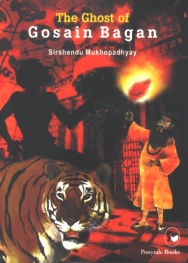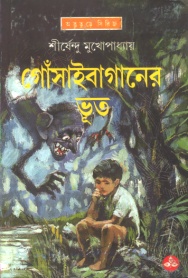

|
Fantasy, Fiction, Fact: Magic and Realism in Sirshendu Mukhopadhyay’s The Ghost of Gosain Bagan Sanjukta Dasgupta
It is a truth universally acknowledged that children’s fiction intended for young readers belonging to well-demarcated age groups that fall under pre-school, primary school and middle school categories is often consumed with amazing hunger by adult readers. Ponytale Books has pegged The Ghost of Gosain Bagan in the 10+ category. The publishers clearly define the agenda of their “publishing programme” by introducing themselves as a “specialist children and young adult imprint” and also state carefully that
“Ponytale Books caters to 8 to 13 age group. Ponytale Books focuses on publishing quality original books that not only entertain and inform, but also subtly educate about universal values, Indian history, culture and tradition in a rapidly globalising world.”
KID LIT
The question that next arises is-- who is the target reader of such translated texts? Will it be Bengali/Indian urban children studying in English medium schools? Can they identify their presumably cosmopolitan English speaking math teacher with Mukherjee’s fascinating Karalibabu? Will the readers be the progeny of the non-resident Bengali/Indians scattered throughout the world? In this context, the remoteness of the world of Burun increases a thousand-fold when compared to the physical and social environment of NRI/PIO children. Moreover, the adult writer’s propensity of involving various adult characters into the children’s texts to play key roles can be challenging for children but attractive for adult readers of children’s fiction. In Mukherjee’s text, as the ghosts are adult ghosts, these ubiquitous spirits contribute to the alienation effect of the text. Children enjoy the roles played by bumbling adults, evil adults, good but eccentric adults rather than sermonizing adults and in this respect The Ghost of Gosain Bagan will not disappoint young readers. However, one cannot fail to notice how male dominated the text is throughout its 117 pages. Except for cursory references to Burun’s mother and sister Beli and that ragged stereotype “womenfolk started crying in both the households” (p. 92) after it was reported that Burun and Bhutum were truly missing, all the fictional characters are either male children or adult males, even the ghosts in the text are all male ghosts.
The fantasy world of talking ghosts such as Nidhiram and the nasal tone ghost, dreams and fantastic sequences that the text re-invigorates in this admirable translation also tells us that the contemporary dreams in the children’s world has drifted away from the dreamworld of Alice in Wonderland and Peter Pan, the timeless fun of Thakurmar Jhuli towards the chic of the Harry Potter series. Even narratives of dreams and fantasies can become dated and obsolete for dreams and fantasies are after all deeply subjective. The dream content is inextricably linked to the subject-- who is fantasizing is a crucial question that helps us in understanding and interpreting the dream, that is, the identity of the dreamer influences the dream. Hence my fears about the reception of the translated text by 10+ readers may not be unfounded, though I sincerely hope I am completely wrong in my conjecture.
Translations of erstwhile local language classics resurrect the archival treasures but may not receive overwhelming contemporary reception due to the fact that in the last fifteen or twenty years the world has changed so rapidly that the timeless classics do not have the same resonance that they had for generations of young minds till maybe the nineteen eighties. Having said that I also intend to assert that it is necessary to continue to build cultural bridges through translations of local texts so that the nuances of regional cultures remain dynamic rather than become archival material for the exclusive use of researchers and engaged readers.
Mukherjee’s fiction begins with ‘failure’. No other horror could be so traumatic to a school going child than low scores in examinations and more so in mathematics, the formidable subject deeply revered by educated and cultured Bengalis. So when Burun returns home with the school progress report recording that he had secured just 13 marks in mathematics, his teachers and parents behaved as if a catastrophe had taken place.
As a matter of fact this psychological therapy as subtext in this slick fiction of 117 pages brings to mind J.K.Rowling’s recent speech at the 2008 Harvard University convocation
(June 5, 2008 Harvard University Gazette online). Rowling ‘s speech primarily prioritized the fringe benefits of failure and the importance of imagination. Rowling had stated, “We do not need magic to change the world. We carry all the power we need inside ourselves already, we have the power to imagine better.”
I am certain now that The Ghost of Gosain Bagan has been brilliantly translated by Nirmal Kanti Bhattacharjee, J.K.Rowling will now be able to read this riveting Bengali fictional text and perhaps wonder how a local writer in India had anticipated the subtext of the Harry Potter series and represented the fringe benefits of failure in a way that represents and negotiates local and global aspirations so magically.
Published August, 2008
|

 The Ghost of Gosain Bagan,by Shirshendu Mukhopadhyay; Translated from the original Bengali by Nirmal Kanti Bhattacharjee; Ponytale Books, Kolkata, India; 2008; P. 117; ISBN:13: 978-81-905748-2-2
The Ghost of Gosain Bagan,by Shirshendu Mukhopadhyay; Translated from the original Bengali by Nirmal Kanti Bhattacharjee; Ponytale Books, Kolkata, India; 2008; P. 117; ISBN:13: 978-81-905748-2-2 
